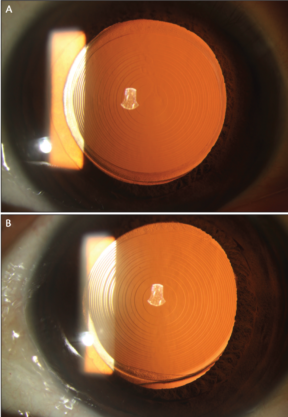Sponsored by VSY Biotechnology

Choun-Ki Joo, MD, PhD
Department of Ophthalmology and Visual Science, Seoul St. Mary’s Hospital, College of Medicine, The Catholic University of South Korea
ckjoo@catholic.ac.kr
Traditional multifocal IOLs focus on restoring near vision. Even though these IOLs improve near and far vision in bright environments, some patients can observe glare and halos in dark environments. Furthermore, although near vision remains important, there has been increasing need for better intermediate vision, such as for working with computers. More recently, trifocal IOLs were developed to enhance intermediate vision as well as near vision. Among the available trifocal IOLs, the AcrivaUD Reviol Tri-ED with enhanced depth of focus can enhance the quality of night vision in addition to near and intermediate vision.
IOL CHARACTERISTICS
In conventional trifocal IOLs, the light distribution under mesopic conditions is rendered dominantly for far vision, thus failing to effectively cover near and intermediate vision. However, the semi-apodized structure of the AcrivaUD Reviol Tri-ED is designed to have consistent light distribution for far, intermediate, and near even when the pupil is dilated. This is because the height of the rings at the center (3-mm) decreases gradually, with the rings in the peripheral portion being of constant height. Light distribution in daylight is 40% far, 30% intermediate, and 30% near; in dim light, the distribution is 44% far, 28% intermediate, and 28% near.
Unlike other trifocal IOLs, which mainly focus on far vision in dark environments, the AcrivaUD Reviol Tri-Ed has advantages for intermediate and near vision and for far vision in dark environments. A unique feature of this IOL is its extended depth of focus, which enhances light transmission between the focal lengths of near, intermediate, and far and forms continuous light distribution from near to far. Thus night vision quality is enhanced by reducing glare and halos.
CASE REPORT
A 56-year-old woman presented with binocular vision deterioration and cataracts in both eyes. BCVA was 20/32 in her right eye and 20/40 in her left. The patient is a ballet stage director, and she indicated that she wanted enhanced near, intermediate, and distance vision. Also, because she works under dim light environment, minimum light scattering such as glare and halos in dark environment would not be tolerated. We discussed her options, and she decided on the AcrivaUD Reviol Tri-ED IOL for both eyes.
At 2 months postoperative, UCVA at far, intermediate (80 cm), and near (40 cm) was 20/20, 20/20, and 20/25, respectively, in her right eye and 20/20, 20/20, and 20/25 in her left. The spherical equivalent manifest refraction was -0.25 D in her right eye and 0.25 D in her left eye, and contrast sensitivity was either better than or within the normal range for normal phakic eyes in the same age group (Figures 1 and 2).1 Subjective satisfaction evaluated by a questionnaire, which revealed that the patient was very satisfied with vision at near, intermediate, and far distances. The patient did not need glasses at near and intermediate distances. Furthermore, she did not complain about blurring, glare, and halo (Figure 3).

Figure 1. Contrast sensitivity in the patient’s right eye; the gray area is considered within the normal range for normal phakic eyes in the same age group.

Figure 2. Contrast sensitivity in the patient’s left eye; the gray area is considered within the normal range for normal phakic eyes in the same age group.

Figure 3. The AcrivaUD Reviol Tri-ED in situ (A,B).
CONCLUSION
AcrivaUD Reviol Tri-ED improves intermediate vision as well as near vision. It further enhances night vision quality by complementing the shortcomings of conventional trifocal IOLs. Therefore AcrivaUD Reviol Tri-ED lens is an appropriate option for patients, who need improved near and intermediate vision and who work under dim light.
1. Hohberger B, Laemmer R, Adler W, Juenemann AG, Horn FK.
Measuring contrast sensitivity in normal subjects with OPTEC(R) 6500: influence of age and glare. Graefes Arch Clin Exp Ophthalmol. 2007;245(12):1805-1814.
